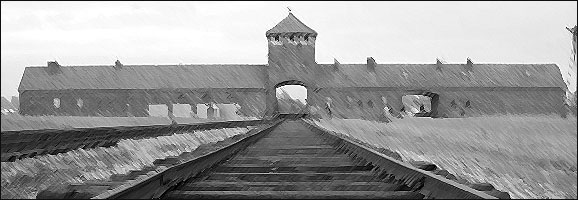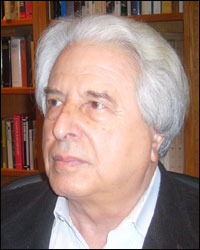History as Obligation: Interview with Friedländer
History as Obligation: Interview with Friedländer
Documenting the Holocaust

Saul Friedländer was born in Prague and spent his childhood in Nazi-run France. When he was nine years old, his parents hid him in a Catholic monastery. Orphaned after the war, Friedländer lived a peripatetic life. He fought in Israel’s War of Independence, studied in Geneva, and eventually became an esteemed historian of the Holocaust at both Tel Aviv University and UCLA. Dissent‘s Jon Wiener (“The Weatherman Temptation“) spoke with Friedländer in Los Angeles about his new book, The Years of Extermination, the second volume of Nazi Germany and the Jews.
Jon Wiener: You open your book The Years of Extermination by describing a photo—an ordinary graduation photo, showing a Jewish man at his graduation from medical school in Amsterdam in September 1942. What’s the significance of this photo?
 Saul Friedländer: I wanted to write an integrated history of the Holocaust. Usually, the various aspects are taken separately—German policy, the actions of bystanders, and the experience of the victims. I wanted to show them together, almost simultaneously. In that photo you see all those elements at once. This was the last Jewish student at University of Amsterdam. The Germans had forbidden Jews to study there after September 16, 1942. The University of Amsterdam allowed him to get his medical doctorate the weekend before the Monday that the German decree took effect. So we see, in the same scene, not only the German order, and the last Jewish student, but also the Dutch attitude. Then in the background you see a few relatives who will be deported—most probably to their deaths—in the next few weeks and months. 75 per cent of Dutch Jews were deported and never came back. Thus in this one photo you have an integrated history of the holocaust.
Saul Friedländer: I wanted to write an integrated history of the Holocaust. Usually, the various aspects are taken separately—German policy, the actions of bystanders, and the experience of the victims. I wanted to show them together, almost simultaneously. In that photo you see all those elements at once. This was the last Jewish student at University of Amsterdam. The Germans had forbidden Jews to study there after September 16, 1942. The University of Amsterdam allowed him to get his medical doctorate the weekend before the Monday that the German decree took effect. So we see, in the same scene, not only the German order, and the last Jewish student, but also the Dutch attitude. Then in the background you see a few relatives who will be deported—most probably to their deaths—in the next few weeks and months. 75 per cent of Dutch Jews were deported and never came back. Thus in this one photo you have an integrated history of the holocaust.
JW: The Nazis worked to rid Germany and Europe of other groups in addition to the Jews, especially gypsies and homosexuals. Was the Nazis’ hostility toward Jews any different from their hostility to these other groups?
SF: The Nazis didn’t start with mass killing of Jews, they started killing the mentally handicapped. The difference between their attitudes towards Jews and others was this: for Hitler, and for his entourage, and for the true believers in the Party, the Jews were not only the enemy of “the New Germany,” and of Aryan humanity, but they were also an active enemy—their only active enemy in the world, the only enemy bent on destroying Germany. In order to prevent them from accomplishing that, they had to be exterminated.
JW: But at the beginning of the war, extermination of Jews was not an official German war aim. You show that, when Germany invaded Poland in 1939 and the SS massacred Jews, the German army, the Wehrmacht, court-martialed the perpetrators. The Nazis didn’t set a policy of extermination until the end of 1941. The policy before that was expulsion. The difference between expulsion and extermination of course is the difference between life and death.
SF: That is correct. The earliest policy, before the war, was expulsion from Germany. That worked for the Nazis to a point, but there were still 200,000 Jews living in Germany when the war started. Then when Poland was occupied and the Germans “inherited” two million Jews, the question became where could they find someplace to expel all those Jews to. They had what they called territorial plans: first the Lublin area of Poland, then, after France was defeated, they considered the island of Madagascar. And finally, after they attacked the Soviet Union, they thought of northern Russia.
JW: What was the historical context in December 1941 in which the “solution to the Jewish question” shifted from deportation to extermination?
SF: Hitler had been convinced that the war with the Soviet Union would be over by October or November, 1941. But by that time the Soviet Army was still fighting, and on December 4 it counterattacked in front of Moscow. For the first time in that war, the Wehrmacht was actually retreating. A few days later came Pearl Harbor and the US entry into the war. That meant this war would now become a total war like the war of 1914-18, where Germany was fighting on both fronts. We don’t know exactly when Hitler made his decision, but the best evidence we have about the decision on extermination comes from Himmler’s diary. There on December 17, 1941, you have a meeting with Hitler on the topic of “the Jewish question,” and there you have Hitler’s order, “exterminate as partisans”—not in the sense of the guerilla fighters on Soviet territory—but as supporters of a cause, as the internal enemy. Hitler went on to say this dozens of times: now that there is total war the Jews, the internal enemy, have to be exterminated so that we will never get back to the situation of 1918, when we were stabbed in the back—by the Jews.
JW: So Hitler turned his full fury on the Jews only after facing the prospect of defeat in Russia and a long war with the US. Beyond these specific events, you show that Hitler’s personal obsession with Jews was absolutely crucial to the history of the Holocaust. But you don’t try to explain it.
SF: I say there is no point really in trying to figure out what was the basis of Hitler’s obsessive hatred of the Jews. His first political letter of 1919 was on the Jews, and the last line of his political will, written a few moments before he committed suicide, dealt with the Jewish question. Many books have been written on that obsession. To me, it’s all a matter of guessing.
JW: You do think we need to understand the German people and why they continued to follow Hitler to the bitter end.
SF: Yes, a great majority of Germans remained faithful to their fuehrer, many of them to the end, and, it has to be admitted, quite a few even after the end. That, for a historian, is a puzzling situation. Stalin was feared by the Russians—admired by only a section of the population. Roosevelt was hated by many people in America. Churchill was hated by many people in England. But in Germany, you find adoration of Hitler—even after Stalingrad, even towards the end when everything was in ruins. The psychology of this I do not understand very well.
JW: In addition to studying the perpetrators, you say we need to understand the bystanders, outside of Germany. You say “at each step in occupied Europe, the execution of German measures depended on the submissiveness of political authorities, the assistance of local police forces, and the passivity or support of the general population and the elites.” You quote an amazing official statement issued by the highest authority of the Catholic Church in Poland in 1936 declaring “it is forbidden to assault, beat up, main, or slander Jews.” That was three years before the war. Once the war started, how many groups or organizations or leaders stood by the Jews in the face of Nazi demands?
SF: Not many, to put it very mildly. Not many in the occupied countries, until 1943, when there are declarations here and there of solidarity. We see extreme encounters where the local populations were very anti-Semitic like Poland. But what is striking is that you see that kind of anti-Semitic action also in countries where you wouldn’t expect it so intensely like France. Even Holland. The populations of occupied Europe ultimately remained passive, didn’t take a side in the persecution of the Jews, said very little when the deportations started, and very little more when the rumors about extermination spread throughout the continent. Poland, of course, is an extreme example—partly because the extermination camps were on Polish soil. But you find this “Polish syndrome” all over Europe.
JW: In your introduction you write that you quote from victims’ diaries because you want to “pierce the smugness of scholarly detachment and ‘objectivity.’” What exactly do you mean?
SF: I hope my book is objective. But as I said at the outset, I wanted to write an integrated history. That idea demanded the presence of the voices of the victims. The history of the Holocaust as it is usually written deals with the decisions of the Germans and their accomplices. And then there is a whole separate literature on the victims. Business-as-usual history flattens the interpretation of mass extermination. But the voices of the victims—their lack of understanding, their despair, their powerful eloquence or their helpless clumsiness—these can shake our well-protected representation of events. They can stop us in our tracks. They can restore our initial sense of disbelief, before knowledge rushes in to smother it.
JW: One final question: How were you able to do this book? How were you able to go to work every morning, for many years, and face this story? As a reader I had to stop many times—first of all on page 28, where you describe Nazi humiliation of orthodox Jews in Poland right after the invasion—and several more times in the 600 pages that follow.
SF: Strangely enough, one gets inured with time. That works, however, only to a point. While some of the most horrifying material elicits no reaction, a very simple letter of the more ordinary kind creates a sudden emotional reaction—i.e., the letter of a young girl writing to her father from Drancy that she is about to be deported, yet tries to assure him that she will be alright. Nonetheless, I considered the completion of these books as a personal and professional obligation that superseded any other considerations.
Jon Wiener teaches history at the University of California, Irvine. His most recent book is Historians in Trouble.





